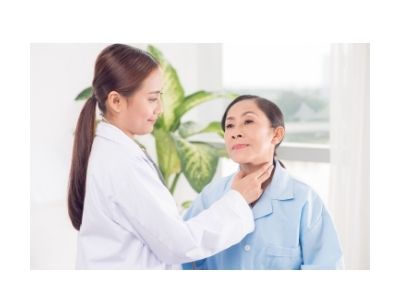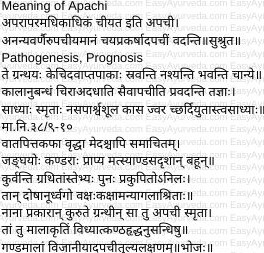Apachi – Symptoms, Pathogenesis, Treatment
By Dr Raghuram Y.S. MD (Ay) & Dr Manasa, B.A.M.S
That swelling which grows more and more, again and again is called as Apachi. Master Sushruta defines Apachi as – ‘That which gets aggregated in different forms in a unique way and also undergoes increase intensively is called as Apachi’.
Master Charaka has mentioned only Gandamala but not Apachi. On the contrary Sushruta has explained only Apachi and not Gandamala.
Read – Granthi: Cystic Swelling, Types, Features, Ayurvedic Treatment

Table of Contents
Pathogenesis, Prognosis
Some of these cysts / glandular swellings get suppurated and break open. They also exhibit discharges. Some of them spontaneously get destroyed, some surface yet again and some get newly manifest. This disease keeps coming and going and stays for longer duration. These swellings are curable. But the Apachi associated with rhinitis, pain in flanks, cough, fever and vomiting is said to be incurable.
Master Bhoja explains Apachi as –
‘Aggravated vata, pitta and kapha along with abnormally increased fat tissue reach the tendons of calf muscles and get lodged therein. They then produce many cystic swellings of fish eggs shape in that region. The vata then takes the other doshas and moves in upward direction and get lodged in chest, axilla, nape of the neck and neck and produce many types of cystic swellings. These swellings are called as Apachi. The same Apachi when forms in the region of neck, heart and joints of the jaw in the form of garland of cystic swellings it will be called as Gandamala’. This explanation shows that Gandamala is a form of Apachi.
Read – Medo Dhatu: Fat Tissue, As Explained In Ayurveda
Symptoms
Glandular swelling in –
- Legs / calves
- Chest
- Axilla
- Nape of the neck
- Neck
- Region of heart
- Joints of the jaw
Types
Master Sushruta has explained two stages of this disease –
Stage 1 – Here, the glandular swellings are manifested which do not undergo suppuration. There is presence of itching and mild pain. According to Master Charaka, this stage is nothing but Gandamala. Charaka has mentioned that Gandamala does occur only in the neck. Master Bhoja too has mentioned that Gandamala is a type of Apachi but according to his explanation this condition occurs at multiple places in the body and is not limited to the neck.
Stage 2 – In this stage the swellings get suppurated, break open and discharges occur.
Read – Types Of Swelling – Ayurveda Diagnosis Charak Samhita Sutrasthan-18
Sanskrit Verses

Modern correlation
Apachi has been compared to a condition called as Lymphadenitis. Since Ayurveda also has explained about its longer course and disease pertaining for longer duration, it can be compared to chronic lymphadenitis. This occurs due to inflammation of the lymph glands in different parts of the body.
Treatment
Internal Medication
Chandanadi Taila
Oil prepared with below ingredients is consumed –
- Sandalwood – Santalum album
- Haritaki – Terminalia chebula
- Laksha – lac
- Vacha – Acorus calamus
- Katukarohini – Picrorhiza kurroa
Gutika
Kanchanara Guggulu is highly effective in curing Apachi.
Medicines for Apachi from Sahasra Yoga Text book
Tiktaka Ghritam
Mahatiktaka Ghritam
Vachadi Thailam
Alambusha Prayoga
Juice of tender leaves of Alambusha – Sphaeranthus indicus is consumed.
Pupalika Prayoga
Pupalika i.e. a kind of sweetened cake is prepared with roots of Vana Karpasika – wild cotton and rice ground together. This is consumed for the cure of apachi.
External medication
Shobhanjanadi Lepa
Warm application of paste made by grinding the bark of Shobhanjana – Moringa oliefera and Devadaru – Cedrus deodara in Kanji – sour gruel.
Sarshapadi Lepa
Mustard, neem leaves and Bhallataka – Semecarpus anacardium are burnt in concealed heating method, ground with goats urine and applied on Apachi.
Ashvattadi Bhasma Lepa
Wood of Ashvattha – Ficus religiosa, Nichula – Barringtonia acutangula and tooth of cow are all burnt together in a concealed heating method. The resultant ash is mixed with bone marrow of boar and applied on Apachi. This destroys ulcers and pus in apachi.
Read – Lepa Kalpana: Ayurvedic Dosage Forms For External Application
Gunjadi Taila Abhyanga
Medicated oil prepared with cows urine and the paste of the below mentioned ingredients –
- Gunja – Abrus precatorius
- Karavira – Nerium indicum
- Shyama – Argyreia nervosa
- Arka – Calotropis gigantea
- Mustard – Brassica nigra
The oil should be processed with these ingredients for 10 times.
After this, smooth powder of below mentioned are added to the oil –
Pippali – Piper longum
Maricha – Piper nigrum
Five type of salts i.e.
- Rock salt
- Black salt
- Vid salt
- Sea salt
- Fossil salt
The ingredients are thoroughly mixed and oil is used for massaging.
Benefits – Used in treating Apachi, sinus ulcers, piles, tumors and ulcers.
Nasal Instillation
Vyoshadi Taila
Nasal drops instilled with oil prepared from decoction of –
- Ginger – Zingiber officinale
- Pepper – Piper nigrum
- Pippali – Piper longum
- Vidanga – Embelia ribes
- Licorice – Glycyrrhiza glabra
- Rock salt
- Devadaru – Cedrus deodara
Read – Nasya Karma Procedure, Types, Benefits, Contra Indications
Cauterization
The physician should make an incision of the shape of the egg of fish 12 angula (finger breadth) above in line with the heel, over the calf muscle, avoiding the Indrabasti Marma – a vital spot in the leg. He should remove carefully the networks from that region and burn it with fire.
Read – Kshara Agnikarma Vidhi – Cauterization- Astanga Hridaya Sutrasthana 30
Rekha Traya Vidhana
Above the wrist joint, with a gap of 1 angula each, physician should make three lines by burning those areas. This is said to cure Apachi.
Aushadha Dharana – Tying medicament on arm
Root of Sahadevi – Vernonia cinerea plucked on Pushya Nakshatra star constellation should be tied on the arm of the patient suffering from Apachi.
Alternatively root of Apamarga – Achyranthes aspera should be tied.
Siravedha – Vein puncture
Two veins located on the under surface of tongue is cut and bloodletting done.
Pathya – apathya according to yogaratnakara
Wholesome herbs, diet and habits
Old ghee, old red rice,barley, green gram, pointed gourd, red variety of drumstick, bitter gourd, dry, pungent and carminative substances, guggul, asphaltum etc.
Unwholesome herbs, diet and habits
Milk and milk products, sugarcane juice and its products, meat of animals of marshy lands, food items prepared from flour, sour, sweet, heavy to digest foods and foods that cause obstruction in the channel of circulation etc.
Click to Consult Dr Raghuram Y.S. MD (Ayu) – Skype









